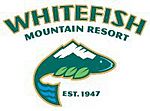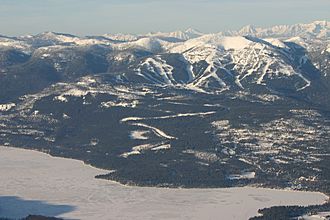Whitefish Mountain Resort facts for kids
Quick facts for kids Whitefish Mountain Resort |
|
|---|---|
 |
|

Aerial view in February 2008
|
|
| Lua error in Module:Location_map at line 416: Malformed coordinates value. | |
| Location | The Big Mountain Flathead National Forest Flathead County, Montana, U.S. |
| Nearest city | Whitefish - 4 miles (6 km) Columbia Falls - 16 miles (26 km) Kalispell - 21 miles (34 km) Missoula - 140 miles (230 km) Spokane - 260 miles (420 km) |
| Coordinates | ACoordinates: Longitude could not be parsed as a number: W {{#coordinates:}}: invalid longitude |
| Vertical | 2,353 ft (717 m) |
| Top elevation | 6,817 ft (2,078 m) |
| Base elevation | 4,464 ft (1,361 m) |
| Skiable area | 3,020 acres (12.2 km2) |
| Runs | 93 |
| Longest run | 3.3 miles (5.3 km) - Hellfire |
| Lift system | 11 chairs - 3 high-speed quad - 8 fixed-grip (2 quad, 6 triple) 3 surface tows |
| Terrain parks | 1 |
| Snowfall | 300 inches (760 cm) |
| Snowmaking | yes |
| Night skiing | Fri & Sat - lower lifts |
| Website | skiwhitefish.com |
Whitefish Mountain Resort is an exciting ski resort located in the beautiful western part of Montana. It sits on a place called Big Mountain. This resort is a great spot for winter sports fans. It is close to Glacier National Park, which is famous for its amazing scenery. The resort is also just 4 miles (6 km) from the town of Whitefish.
Contents
Exploring the Slopes: Lifts and Trails
Whitefish Mountain Resort has many ways to get up the mountain. It has eleven chairlifts and three surface lifts. These lifts help skiers and snowboarders reach different parts of the mountain.
Types of Lifts at Whitefish
- Chairlifts: There are three fast high-speed quad chairlifts. A quad means it carries four people. There are also six fixed-grip chairlifts. These include two quads and four triples (carrying three people).
- Surface Lifts: You can also find two T-bar lifts and one magic carpet. A magic carpet is like a moving walkway for beginners.
- Most of these lifts run regularly. One T-bar lift is usually open on weekends.
Mountain Faces and Skiing Areas
The mountain has three main areas, or "faces," for skiing:
- Front Side: This is the biggest area for skiing. The Big Mountain Express, a fast quad chairlift, serves most of this side. Another fast quad, the Swift Creek Express, helps beginners and intermediate skiers. The front side has seven of the resort's chairlifts.
- Backside: This area is great for skiing through trees. The Big Creek Express, another fast quad, takes you there. You can also reach more terrain using T-Bar 2 on weekends and holidays. The Flower Point and East Rim chairlifts also serve this side.
- Hell Roaring Basin: This is the most challenging area. It has cliffs, steep drops, and tight tree skiing. The Hellroaring triple chairlift takes you to this exciting basin.
Longest Run and Mountain Stats
The longest trail at Whitefish Mountain Resort is called Hellfire. It is about 3.3 miles (5.3 km) long. It goes all the way from the top of the mountain to the base of Chair 8.
Sometimes, the clouds at Whitefish Mountain Resort are so low that skiers can actually ski above the clouds! It's a really cool experience.
- Vertical Drop: The total height difference from the top to the bottom of the ski area is 2,353 feet (717 m).
- Summit Elevation: The highest point you can ski is 6,817 feet (2,078 m) above sea level.
- Base Elevation: The lowest point of the ski area is 4,464 feet (1,361 m) above sea level.
- Average Snowfall: The mountain gets about 300 inches (760 cm) of snow each year. That's a lot of fresh powder!
The ski area is also easy to get to. It's about nineteen miles (31 km) north of Glacier Park International Airport. It's also about 35 miles (56 km) south of the Canada–US border.
History of Whitefish Mountain Resort
The resort has a long and interesting history, starting many years ago.
Early Days as Big Mountain
The resort first opened on December 14, 1947. It was called Big Mountain back then. A company called Winter Sports, Inc. (WSI) started it. In March 1949, Big Mountain hosted a big skiing competition called the U.S. Alpine Championships. A young skier named Andrea Mead Lawrence won three titles there when she was just sixteen. At first, the mountain only had one T-bar lift. Later, in the 1960s, chairlifts were added.
Renaming and Growth
After sixty years, in June 2007, the resort changed its name to "Whitefish Mountain Resort." By this time, it had grown a lot and had ten chairlifts.
Famous Skiers and Events
- Tommy Moe: An Olympic champion skier named Tommy Moe learned to ski and race at this mountain. His father was even on the ski patrol there! Tommy Moe won a gold medal and a silver medal at the 1994 Winter Olympics in Lillehammer, Norway.
- U.S. Alpine Championships 2001: The mountain hosted the U.S. Alpine Championships again in 2001. This event is remembered for a serious accident involving Bill Johnson, an Olympic downhill champion from 1984.
Recent Changes
In early 2008, there was an avalanche in the nearby Flathead National Forest. Later that year, the resort changed its rules about summer lift access for people with winter passes. They decided to give free lift tickets instead. However, in September 2008, they changed their minds again. They announced that winter season passes for 2008–09 would once again include unlimited summer lift access for walking.
See also
 In Spanish: Whitefish Mountain Resort para niños
In Spanish: Whitefish Mountain Resort para niños

